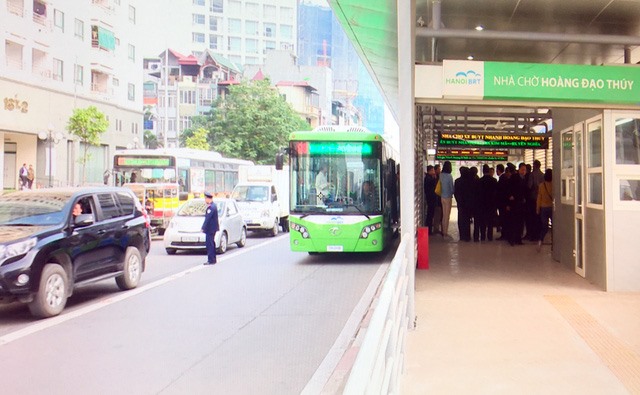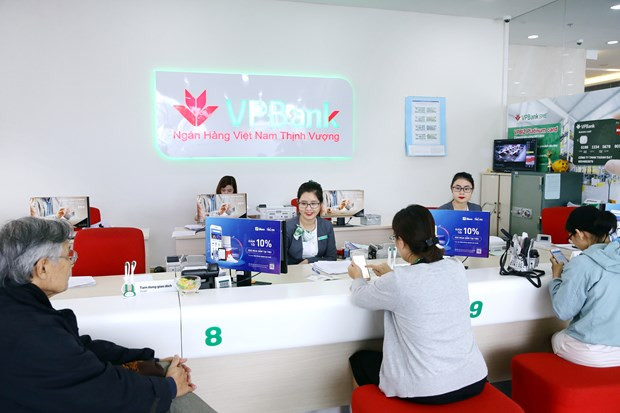 Society
Society

" />City dwellers and experts are concerned about the effectiveness of the bus rapid transit (BRT) route connecting Kim Mã and Yên Nghĩa, which is being launched later this month.
 |
| A Hà Nội’s rapid bus runs trial on Hoàng Đạo Thúy Street. - VNA/VNS Photo |
HÀ NỘI — City dwellers and experts are concerned about the effectiveness of the bus rapid transit (BRT) route connecting Kim Mã and Yên Nghĩa, which is being launched later this month.
The city’s transport department says the rapid bus system is designed to serve the travelling public and reduce traffic jams in the capital. A one-way ticket will cost VNĐ7,000 (30 US cents) and is expected to cut travel time in half compared to travelling on a regular bus.
However, to ensure the smooth operation of the rapid bus, the Hà Nội administration has recently given the green light to banning certain vehicles at rush hours, between 6am and 9am, and 4:30pm and 7:30pm, as of December 25.
In the first stage, trucks with a capacity of above 500 kilos will be banned from Lê Trọng Tấn, Tố Hữu and Vạn Phúc streets. Taxis will be prohibited from driving on Giảng Võ, Láng Hạ and Lê Văn Lương streets. The ban will also be applied to trucks and motorbikes in the two flyovers of Láng Hạ-Huỳnh Thúc Kháng and Lê Văn Lương–Láng to enable the rapid bus to complete its 14km route in about 30 minutes.
A city dweller, Đào Hoàng Phương, 28, said that if motorbike drivers are banned from the two flyovers at rush hour, they would be forced to drive on other roads and create traffic jams there. “So, if one of the aims of bus rapid transit is to curb traffic jams in the city, will that be achieved?” he asked.
Talking to the Tiền Phong (Vanguard) newspaper, economic expert Lưu Bích Hồ asked: “How many people will choose to travel by rapid bus? Is it really worth to force a lot of motorbike and taxi drivers to change their routes and trigger traffic congestion?"
Mai Hải Đăng, head of International Training at the University of Transport, said banning taxis would cause inconveniences to people who prefer to use their service. In other countries, taxis are considered a means of public transport and allowed to operate like buses, he said.
Nguyễn Xuân Thủy, an expert on urban traffic, told the Lao Động (Labour) newspaper that running a bus rapid transit route but banning other vehicles was illogical. Ensuring the smooth operation of the rapid buses by causing traffic jams in other streets was not a good idea, he said.
Initial solutions
Thủy said instead of banning other vehicles to make room for rapid buses, the city should let both rapid buses and other vehicles run together at first, and then adjustments would be made depending on the results, he added.
Bùi Danh Liên, president of the Hà Nội Transport Association, said at first, when the rapid buses start running, traffic congestion might occur in streets that motorbikes use instead of the two flyovers. Traffic police should patrol the streets to separate lanes and ensure smooth traffic for vehicles. This would reduce traffic congestion, he said.
Phạm Hoài Chung, head of the Urban Transport Development Centre under the Transport Development and Strategy Institute, said the route that the rapid bus was scheduled to use has a high traffic flow. Therefore, several types of vehicles have to be limited at specific times to give priority to the rapid buses, he said. Troubles will occur at first, he added, but solutions would be found to resolve them.
Chung said development of rapid buses was the global trend. “We really need a consensus from people so that we can effectively run these kinds of buses,” he said.
Residents of Thailand were also critical when the buses were first introduced, but eventually the project was deemed a success, he said.
It is estimated that Hà Nội suffers damage of VNĐ15 trillion (US$660 million) due to traffic congestion each year. — VNS




